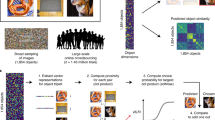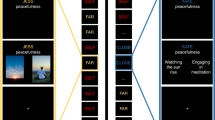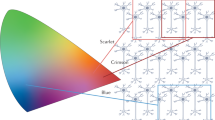Abstract
States of the brain represent states of the world. But at least some of the mind–brain's internal representations, such as a sensation of heat or a sensation of red, do not resemble the external realities that they represent: mean kinetic energy (temperature) or electromagnetic reflectance (colour). The historical response has been to distinguish between objectively real properties, such as shape and motion, and subjective properties, such as heat and colour. However, this approach leads to trouble. A challenge for cognitive neurobiology is to characterize, in general terms, the relationship between brain models and the world. We propose that brains develop high-dimensional maps, the internal distance relationships of which correspond to the similarity relationships that constitute the categorical structure of the world.
This is a preview of subscription content, access via your institution
Access options
Subscribe to this journal
Receive 12 print issues and online access
$189.00 per year
only $15.75 per issue
Buy this article
- Purchase on Springer Link
- Instant access to full article PDF
Prices may be subject to local taxes which are calculated during checkout






Similar content being viewed by others
References
Hoffman, D. D. Visual Intelligence (Norton, New York, 1998).
Wolpert, D. M., Ghahramani, Z. & Jordan, M. I. An internal model for sensorimotor integration. Science 269, 1180–1182 (1995). | PubMed |
Grush, R. Self, world and space: on the meaning and mechanisms of egocentric and allocentric spatial representation. Brain Mind 1, 59–92 (2000).
Churchland, P. S. Brain-Wise: Studies in Neurophilosophy (MIT Press, Cambridge, Massachusetts, 2002).
Churchland, P. M. The Engine of Reason, The Seat of the Soul (MIT Press, Cambridge, Massachusetts, 1996).
Suri, R. E. Anticipatory responses of dopamine neurons and cortical neurons reproduced by internal model. Exp. Brain Res. 140, 234–240 (2001).
Damasio, A. R. The Feeling of What Happens (Harcourt Brace, New York, 1999).
Gazzaniga, M. S. Cerebral specialization and interhemispheric communication. Brain 123, 1293–1326 (2000).
Galileo The Assayer (1623) in The Scientific Background to Modern Philosophy: Selected Readings (ed. Matthews, M. R.) 56–60 (Hackett, New York, 1989).
Locke, J. An Essay Concerning Human Understanding (1690). Modern edition (ed. Nidditch, P. H.) 544–547 (Oxford Univ. Press, Oxford, UK, 1975).
Berkeley, G. in Berkeley's Philosophical Writings (ed. Armstrong, D.) (Macmillan, New York, 1965).
Kant, I. Critique of Pure Reason (1781). Modern edition (eds Guyer, P. & Wood, A.) (Cambridge Univ. Press, Cambridge, UK, 1998).
Hegel, G. Phenomenology of Spirit (1807). Translated by Miller, A. V. (Oxford Univ. Press, Oxford, UK, 1977).
Kaufman, L. & Rock, I. The moon illusion: I. Science 136, 953–961 (1962).
Palmer, S. E. Vision Science (MIT Press, Cambridge, Massachusetts, 1999).
Purves, D., Lotto, R. B., Williams, S. M., Nundy, S. & Yang, Z. Why we see things the way we do: evidence for a wholly empirical strategy of vision. Phil. Trans. R. Soc. Lond. B 356, 285–297 (2001). PubMed
Ramachandran, V. S. Filling gaps in perception: part II. Scotomas and phantom limbs. Curr. Dir. Psychol. Sci. 2, 56–65 (1993).
von Helmholtz, H. L. F. Treatise on Physiological Optics (1866). Translated by Southall, J. P. C. (Dover, New York, 1925).
Gregory, R. L. The Intelligent Eye (McGraw–Hill, New York, 1970).
Shepard, R. N. & Chipman, S. Second-order isomorphism of internal representations: shapes of states. Cogn. Psychol. 1, 1–7 (1970).
Glymour, C. The Mind's Arrows: Bayes Nets and Graphical Causal Models in Psychology (MIT Press, Cambridge, Massachusetts, 2001).
O'Brien, G. & Opie, J. in Representations in Mind: New Approaches to Mental Representation (eds Clapin, H., Staines, P. & Slezak, P.) (Greenwood, Westport, Connecticut, in the press).
Sutton, R. S. & Barto, A. G. Reinforcement Learning: an Introduction (MIT Press, Cambridge, Massachusetts, 1998).
Hutchins, E. Cognition in the Wild (MIT Press, Cambridge, Massachusetts, 1995).
Tomasello, M. The Cultural Origins of Human Cognition (Harvard Univ. Press, Cambridge, Massachusetts, 1999).
Bacon, F. Novum Organum (1660). Modern edition (eds Jardine, L. & Silverthorne, M.) (Cambridge Univ. Press, Cambridge, UK, 2000).
Medawar, P. B. Advice to a Young Scientist (Basic Books, New York, 1981).
Crick, F. H. C. What Mad Pursuit: a Personal View of Scientific Discovery (Basic Books, New York, 1988).
Spirtes, P., Glymour, C. & Scheines, R. Causation, Prediction, and Search (Springer, New York, 1993).
Acknowledgements
We are grateful for advice and assistance from F. Crick, A. Damasio, L. Goble, E. McAmis and S. Rickless.
Author information
Authors and Affiliations
Corresponding author
Related links
Related links
FURTHER INFORMATION
Donald D. Hoffman's laboratory
Edward H. Adelson's laboratory
MIT Encyclopedia of Cognitive Sciences
Rights and permissions
About this article
Cite this article
Churchland, P., Churchland, P. Neural worlds and real worlds. Nat Rev Neurosci 3, 903–907 (2002). https://doi.org/10.1038/nrn958
Issue Date:
DOI: https://doi.org/10.1038/nrn958
This article is cited by
-
Representations gone mental
Synthese (2014)
-
Consciousness as recursive, spatiotemporal self-location
Psychological Research PRPF (2010)
-
Beyond phrenology, at last
Nature Reviews Neuroscience (2003)



